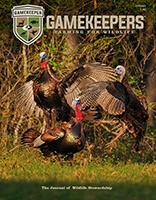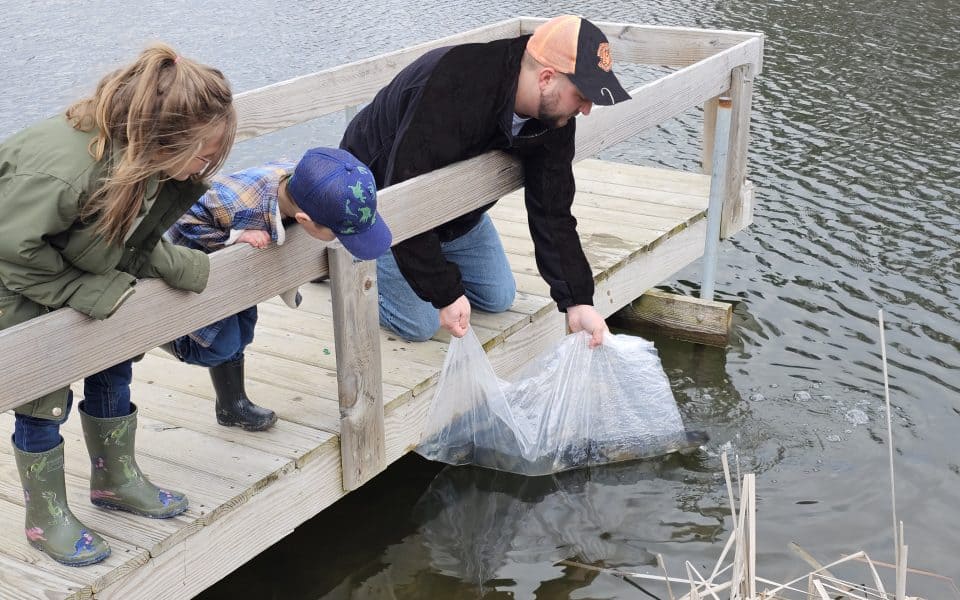If you’ve ever thought about stocking your pond with fish, you might imagine it’s as simple as getting a few buckets of fish, dumping them in, and calling it a day. But just like planting a food plot or setting up the perfect hunting spot, there’s a bit more to it than that. A well‑stocked pond isn’t merely about having fish—it’s about creating a balanced ecosystem that supports healthy growth, natural reproduction, and an enjoyable fishing experience.
For most of us, discussions about balanced ecosystems can make us zone out. Yet, this topic is truly fascinating. At its most basic, a healthy pond requires aquatic vegetation and a diverse mix of fish species that maintain a robust predator‑prey relationship. Native plants and modest amounts of various algae not only feed and shelter your fish but also provide oxygen to the water. (Unless you’ve dug a brand‑new pond, nature has likely already taken care of the vegetation.)
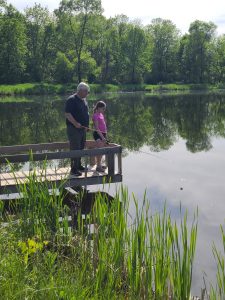
Jack Ammerman
The Mistake That Turned Out to Be Beneficial
When I built a small 6,000‑square‑foot farm pond as a beginner, it was barren of vegetation. I knew it would take time for the pond to look “natural,” so I planned to wait before stocking it. However, I grew impatient and introduced a dozen aquarium‑sized goldfish just to see what would happen. Long story short, they thrived—five years later, those 12 goldfish have multiplied to around 700! Witnessing their rapid proliferation, I began planning to remove the goldfish. After all, who wants a pond full of tiny, orange fish? Predator fish, that’s who!
A year after digging the pond and releasing the goldfish, I introduced a dozen 4‑inch channel catfish. Today, those catfish exceed two feet in length, have reproduced, and offer an exciting fishing experience. I still wish I hadn’t released the goldfish and would have instead stocked the pond with fathead minnows, shiner minnows, or even shad minnows. I’m not sure what I was thinking, but the catfish bellies are now full of goldfish! This year, I plan to add between six and eight largemouth bass, now that the food supply is no longer a concern.
“Just Catch Some Bass and Release Them in Your Pond” – No! Don’t Do It!
Although it might seem like a sound idea, nothing could be further from the truth. Many states have regulations against transplanting fish from one body of water to another. Even if it were allowed, every water body has its unique ecosystem. Fish that thrive in one environment may falter in another—this can lead to disastrous consequences.
Fish can harbor parasites and diseases that might not be present in your pond. Leeches, fish lice, gill flukes, and other parasites may live on a fish’s skin, while internal parasites like tapeworms and roundworms can reside in the gills or organs. When you move fish, you also transfer these organisms directly into your pond, which then may exhibit negative effects rapidly. Although purchasing healthy, certified fish might cost a few extra dollars, it’s a wise investment.
Why Buying Fish Is the Best Answer in the Long Run
For long‑term pond health, purchasing fish from a licensed farm is the best option. Licensed farms ensure their stock undergoes the necessary health checks and treatments, significantly reducing the risk of introducing diseases and parasites.
Another benefit of buying young fish is that they are often bred for desirable traits such as rapid growth, disease resistance, and specific sizes or colors. Many pond owners seek hybrid bluegills for their fast growth and voracious appetite—a quality that creates a lively fishing experience.
When purchasing from a licensed fish farm, ask as many questions as possible—the experts in this field know the ins and outs of raising healthy fish. The fish you buy typically come from a carefully monitored environment that ensures their quality and health.
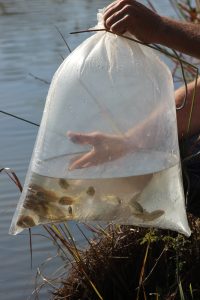
FarHorizonFarm
Stocking a Pond
When it comes to stocking your pond, size truly matters. A small, quarter‑acre farm pond has different needs than a larger, multi‑acre water body. Although I offer some general guidelines here, I still recommend consulting a reputable fish farm expert for advice on your specific pond.
When to Stock
The ideal time to stock is from late April through early June. During this period, water temperatures rise, fish are actively feeding, and their metabolisms efficiently convert food into growth. In spring, forage fish spawn, providing a natural food source for the new fish. If you miss this window, September and October are also good options, as fish resume active feeding. The key is to avoid releasing fish during the peak heat of summer.
Stocking during summer presents challenges. High water temperatures reduce oxygen levels, stressing fish and making them more susceptible to disease. Even if you choose to stock during the summer, consider doing so either late in the evening or very early in the morning when the water is a few degrees cooler near the surface.
Handling Your New Fish
Fingerlings for stocking are generally transported in hauling tanks with aeration or in sealed bags with oxygen. Upon arrival you’ll want to gradually acclimate the fish to their new environment. If you have a larger hauling tank, slowly replace the water with water from the pond to be stocked. This can be done with a small pump or with buckets. If you receive a smaller amount of fish they will be placed in a large plastic bag containing cold, clean water. This cold water slows the fish’s metabolism and reduces their oxygen consumption. Additionally, the bag is usually inflated with 100% oxygen, enhancing the fish’s chances of surviving the trip to your pond.
Upon arriving, resist the urge to immediately release the fish into the pond. The water from the bag is significantly colder than your pond’s water, and a sudden temperature change may cause thermal shock. Instead, place the bag in your pond and let it acclimate for 15 to 30 minutes, allowing the water temperature inside the bag to gradually match that of your pond. Although those 30 minutes may seem long, they are crucial for the fish’s well‑being.
Also, tie a rope to the bag and secure it to a dock or the shoreline—this small precaution can prevent accidental drifting. Finally, release the fish gently by opening or cutting the bag and letting them swim out on their own. Unlike large commercial stocking trucks that may cause significant stress and loss, a gentle release helps ensure the survival and health of every fish.
Another key tip is to release the fish in an area with adequate cover. When I release fish near my dock, they immediately swim under the structure for shelter as they acclimate. Releasing them near aquatic vegetation, submerged structures, or rock piles offers similar benefits—especially for smaller fish in the presence of predators.
Editor in Chief of this publication, Todd Amenrud, says he learned his lesson regarding releasing fish near cover several years ago when bringing in 1,000 walleye fingerlings. He says, “As fast as we could release them, largemouth bass would come in and pick them off one by one. It wasn’t until we had lost what I estimate to be over half of the fish we had released before we developed a different plan and released the rest in amongst some cattails and cover.”
The Most Popular Fish to Add to Your Pond
It depends upon your location north to south—are you stocking a southern pond created by a dam in Alabama, an old gravel pit pond in Ohio, or an excavated pond in Wisconsin? It also hinges on the pond’s depth, vegetation, for which species you prefer to go after and numerous other factors as to which will flourish and perform best for your needs. Regardless, a few species consistently rise to the top when it comes to stocking a pond:
Largemouth Bass
Often regarded as the king of sport fish, largemouth bass are a top choice for many pond owners. Their aggressive feeding habits and exciting fights make them a favorite among anglers. As predators, they require a healthy forage base—typically bluegill, minnows, or shad—to maintain the pond’s balance. They thrive in areas with ample cover such as submerged vegetation, fallen trees, or rock piles, they prefer water temperatures between 65°F and 85°F, spawn in shallow waters during the spring, and can grow to impressive sizes in a well‑maintained pond.
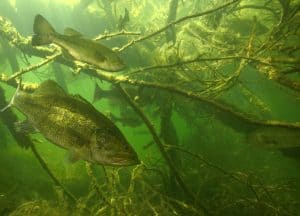
Engbretson Underwater Photography
Bluegill
Bluegill are the backbone of many farm ponds. Serving as a primary forage fish and game fish, they provide a vital food source for largemouth bass and other predators, fun for kids to catch and a tasty meal for the family. Bluegills are prolific breeders, ensuring a sustainable food supply. They flourish in shallow water with plenty of vegetation and are relatively easy to catch—making them an excellent choice for family fishing.
Channel Catfish
Known for their hardiness and delicious flavor, channel catfish can tolerate a wide range of water conditions and are relatively easy to raise. As omnivores, they feed on insects, crustaceans, and small fish, offering additional angling opportunities for those who may also want to harvest fish for food.
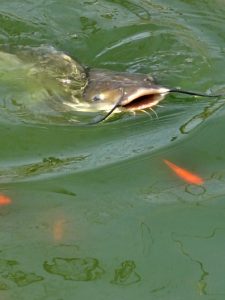
Jack Ammerman
Rainbow Trout
Rainbow trout are ideal for ponds with cooler water temperatures. Their striking coloration and excellent fighting ability make them popular. They prefer well‑oxygenated water and thrive in temperatures below 70°F. Although primarily insectivores, they also consume small fish and crustaceans, making them a favorite for seasonal fishing and fly fishing.
Brown Trout
Much like rainbow trout, brown trout favor cooler water and are prized for their fighting ability and elusive nature. They can tolerate slightly warmer temperatures than rainbow trout but still prefer conditions below 70°F. As primarily piscivores (feeding on fish) they tend to be more cautious and challenging to catch, providing a rewarding challenge for anglers. Brown trout are particularly well‑suited for ponds with deep, cool areas.
Crappies
While crappies are popular in larger lakes and reservoirs, they are generally not recommended for most small farm ponds. They breed prolifically and can quickly overpopulate a pond, leading to stunted growth and intense competition for resources. Moreover, they may disrupt the pond’s ecosystem by preying on young bass and bluegill. Although crappies can be fun to catch and tasty to eat, managing them in a small pond is challenging.
When stocked in the proper ratios, these species can create a thriving and enjoyable pond ecosystem. Remember to consult with a fish farm expert to determine the best stocking plan for your specific pond.
Join our weekly newsletter or subscribe to Gamekeepers Magazine.
Your source for information, equipment, know-how, deals and discounts to help you get the most from every hard-earned moment in the field.
